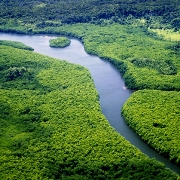How to make the most of tropical forests
07 October 2008 | News story
Indigenous people and policy makers were brought together to discuss the best way to preserve tropical forests at the IUCN World Conservation Congress.
Leading policy makers, such as Barnabas Suebu, Governor of the Indonesian province Papua, and a Quechuan indigenous leader from the Ecuadorian Amazon, Johnson Cerda, discussed how saving forests could alleviate poverty and help fight climate change.
“Conserving and restoring forests for existing carbon markets is seen by many as an important opportunity for achieving effective climate change mitigation and saving biodiversity and benefiting livelihoods,” says Dr Joshua Bishop, IUCN’s Chief Economist. “Policymakers have begun to recognize the importance of tropical forests in climate change mitigation.”
Deforestation and land change contribute at least 20 percent of annual global greenhouse gas emissions. All major sources of greenhouse gas emissions, including emissions from tropical deforestation and degradation, must be dramatically reduced to avert catastrophic impacts on people and biodiversity due to climate change.
The importance of involving indigenous peoples at high level negotiations – a technique used by IUCN – was highlighted.
REDD, which stands for Reducing Emissions from Deforestation and Forest Degradation, is one example of a technique that can be used to ensure forest carbon activities conserve biodiversity as well as help alleviate poverty.
Other participants of the workshop included Glenn Prickett, Senior Vice President for Business and US Governmental Relations, Conservation International, Jill Blockhus, Senior Policy Advisor, The Nature Conservancy, and Johannes Ebeling, Senior Consultant, EcoSecurities.






